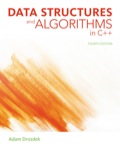
Concept explainers
String functions:
The string functions and their purpose is shown below:
- The function “strcpy(s1,s2)” copies string “s2” into “s1”.
- The function “strcat(s1,s2)” concatenates string “s2” on end of “s1”.
- The function “strlen(s1)” returns length of “s1”.
- The function “strchr(s1,ch)” would return a pointer to first presence of character “ch” in string “s1” .
Explanation of Solution
//(b)strcmp function
The function “strcmp()” compares two strings. It takes header pointer of two strings as function arguments, it checks until the string reaches null and compares both strings by comparing each character at corresonding position ...
Explanation of Solution
//(c) Strcat function
The function “Strcat()” copies data of “s2” to “s1”. To do so, it first reaches end of the string “s1” using recursive calls “Strcat(++s1, s2)”...
Explanation of Solution
//(d) Strchr function
The function “Strchr()” searches for a particular character in string. It iterates through character array and compares each character with search character, if it matches then the index of match is returned.
char* Strchr(char *s, char ch)
{
/*It checks for each character in string and compares it with that of the search string until the character array reaches null or it becomes empty. If a match is obtained, then store index of match*/
for ( ; *s != ch && *s != '\0'; s++);
//Return index of matched character
return *s == ch ? s : 0;
}
The main function defines two character array and tests the functions “Strlen()”, “Strcmp()”, “Strchr()”, “Strcat()” and displays the final result based on the return values of each functions
int main()
{
//Declare the variable
int ret;
//Declare character arrays
char str1[100] = "Drowning";
char *str2 = "Boat";
//Declare pointer of string
char *pch;
//Declare variables
int length ;
//Call the function "strlen()" and store the return value
length = Strlen(str1);
//Display first string
cout<<"String1: ";
puts(str1);
//Display second string
cout<<"String2: ";
puts(str2);
//Display the length of first string
cout<<"\nLength of String1 :"<< length;
//Call the function "Strcmp()" and store the return value of function
ret = Strcmp(str1,str2);
If return value is less than 0, then “String1” is less than “String2”. If return value is greater than 0, then “String2” is less than “String1”, else “String1” equals “String2”.
if(ret < 0)
{
//Display the result
cout<<"\nString1 is less than String2";
}
If return value is greater than 0, then “String2” is less than “String1”
else if(ret > 0)
{
//Display the result
cout<<"\nString2 is less than String1";
}
If “String1” equals “String2”, display the equal message
//"String1" equals "String2"
else
{
//Display the result
cout<<"\n String1 equals String2";
}
The function “Strchr()” is called with “str1” and search character “r” as argument, function’ sreturn value is stored, that is , the value of matched index...
Want to see the full answer?
Check out a sample textbook solution
Chapter 1 Solutions
EBK DATA STRUCTURES AND ALGORITHMS IN C
 C++ Programming: From Problem Analysis to Program...Computer ScienceISBN:9781337102087Author:D. S. MalikPublisher:Cengage Learning
C++ Programming: From Problem Analysis to Program...Computer ScienceISBN:9781337102087Author:D. S. MalikPublisher:Cengage Learning Systems ArchitectureComputer ScienceISBN:9781305080195Author:Stephen D. BurdPublisher:Cengage Learning
Systems ArchitectureComputer ScienceISBN:9781305080195Author:Stephen D. BurdPublisher:Cengage Learning C++ for Engineers and ScientistsComputer ScienceISBN:9781133187844Author:Bronson, Gary J.Publisher:Course Technology Ptr
C++ for Engineers and ScientistsComputer ScienceISBN:9781133187844Author:Bronson, Gary J.Publisher:Course Technology Ptr Microsoft Visual C#Computer ScienceISBN:9781337102100Author:Joyce, Farrell.Publisher:Cengage Learning,
Microsoft Visual C#Computer ScienceISBN:9781337102100Author:Joyce, Farrell.Publisher:Cengage Learning, New Perspectives on HTML5, CSS3, and JavaScriptComputer ScienceISBN:9781305503922Author:Patrick M. CareyPublisher:Cengage Learning
New Perspectives on HTML5, CSS3, and JavaScriptComputer ScienceISBN:9781305503922Author:Patrick M. CareyPublisher:Cengage Learning EBK JAVA PROGRAMMINGComputer ScienceISBN:9781337671385Author:FARRELLPublisher:CENGAGE LEARNING - CONSIGNMENT
EBK JAVA PROGRAMMINGComputer ScienceISBN:9781337671385Author:FARRELLPublisher:CENGAGE LEARNING - CONSIGNMENT





